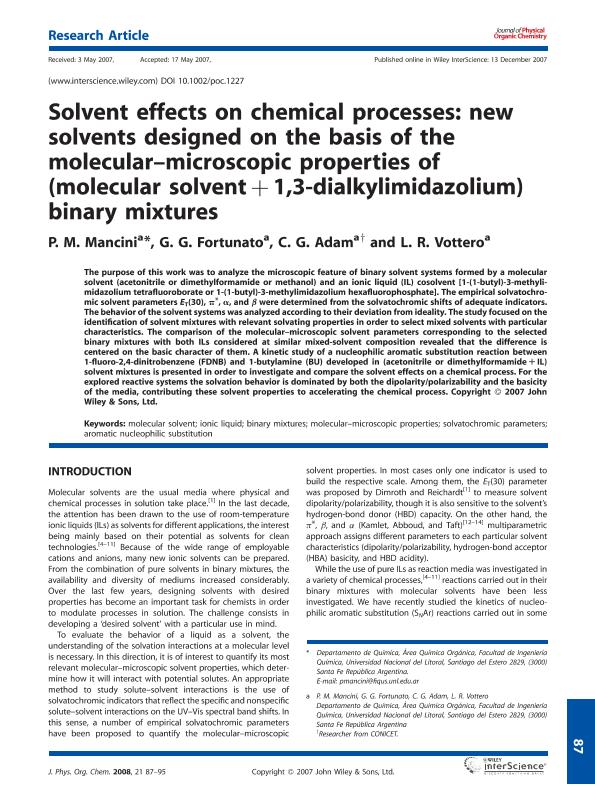Mostrar el registro sencillo del ítem
dc.contributor.author
Mancini, Pedro Maximo Emilio

dc.contributor.author
Fortunato, Graciela Guadalupe

dc.contributor.author
Adam, Claudia Guadalupe

dc.contributor.author
Vottero, L. R.
dc.date.available
2020-09-16T14:59:55Z
dc.date.issued
2008-02
dc.identifier.citation
Mancini, Pedro Maximo Emilio; Fortunato, Graciela Guadalupe; Adam, Claudia Guadalupe; Vottero, L. R.; Solvent effects on chemical processes: New solvents designed on the basis of the molecular-microscopic properties of (molecular solvent + 1,3-dialkylimidazolium) binary mixtures; John Wiley & Sons Ltd; Journal Of Physical Organic Chemistry; 21; 2; 2-2008; 87-95
dc.identifier.issn
0894-3230
dc.identifier.uri
http://hdl.handle.net/11336/114120
dc.description.abstract
The purpose of this work was to analyze the microscopic feature of binary solvent systems formed by a molecular solvent (acetonitrile or dimethylformamide or methanol) and an ionic liquid (IL) cosolvent [1-(1-butyl)-3- methylimidazolium tetrafluoroborate or 1-(1-butyl)-3-methylimidazolium hexafluorophosphate]. The empirical solvatochromic solvent parameters E T(30), π*, α, and β were determined from the solvatochromic shifts of adequate indicators. The behavior of the solvent systems was analyzed according to their deviation from ideality. The study focused on the identification of solvent mixtures with relevant solvating properties in order to select mixed solvents with particular characteristics. The comparison of the molecular-microscopic solvent parameters corresponding to the selected binary mixtures with both ILs considered at similar mixed-solvent composition revealed that the difference is centered on the basic character of them. A kinetic study of a nucleophilic aromatic substitution reaction between 1-fluoro-2,4-dinitrobenzene (FDNB) and 1-butylamine (BU) developed in (acetonitrile or dimethylformamide + IL) solvent mixtures is presented in order to investigate and compare the solvent effects on a chemical process. For the explored reactive systems the solvation behavior is dominated by both the dipolarity/polarizability and the basicity of the media, contributing these solvent properties to accelerating the chemical process.
dc.format
application/pdf
dc.language.iso
eng
dc.publisher
John Wiley & Sons Ltd

dc.rights
info:eu-repo/semantics/openAccess
dc.rights.uri
https://creativecommons.org/licenses/by-nc-sa/2.5/ar/
dc.subject
AROMATIC NUCLEOPHILIC SUBSTITUTION
dc.subject
BINARY MIXTURES
dc.subject
IONIC LIQUID
dc.subject
MOLECULAR SOLVENT
dc.subject
MOLECULAR-MICROSCOPIC PROPERTIES
dc.subject
SOLVATOCHROMIC PARAMETERS
dc.subject.classification
Química Orgánica

dc.subject.classification
Ciencias Químicas

dc.subject.classification
CIENCIAS NATURALES Y EXACTAS

dc.title
Solvent effects on chemical processes: New solvents designed on the basis of the molecular-microscopic properties of (molecular solvent + 1,3-dialkylimidazolium) binary mixtures
dc.type
info:eu-repo/semantics/article
dc.type
info:ar-repo/semantics/artículo
dc.type
info:eu-repo/semantics/publishedVersion
dc.date.updated
2020-09-03T19:23:48Z
dc.journal.volume
21
dc.journal.number
2
dc.journal.pagination
87-95
dc.journal.pais
Reino Unido

dc.journal.ciudad
Londres
dc.description.fil
Fil: Mancini, Pedro Maximo Emilio. Universidad Nacional del Litoral; Argentina
dc.description.fil
Fil: Fortunato, Graciela Guadalupe. Universidad Nacional del Litoral; Argentina
dc.description.fil
Fil: Adam, Claudia Guadalupe. Universidad Nacional del Litoral; Argentina. Consejo Nacional de Investigaciones Científicas y Técnicas; Argentina
dc.description.fil
Fil: Vottero, L. R.. Universidad Nacional del Litoral; Argentina
dc.journal.title
Journal Of Physical Organic Chemistry

dc.relation.alternativeid
info:eu-repo/semantics/altIdentifier/doi/http://dx.doi.org/10.1002/poc.1227
Archivos asociados
